Silence. There is an overwhelming silence that dominates the Isidor Kaufmann masterpiece, Rabbi with Young Student (catalogue #93) offered for sale at the Sotheby’s December 19th auction. Kaufmann’s most engaging paintings for me are the deeply psychological portraits, usually of Hasidic men, young women and youths.
It is noteworthy that Kaufmann (1853-1921) and Freud (1856-1939) were contemporaries and both lived in Vienna during the same period. The traditionally dressed sitters always directly engage the viewer. From the intensity of their gaze it is clear that
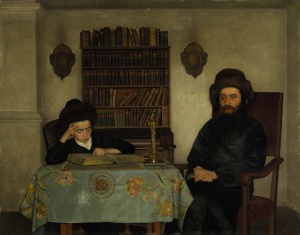
they all possess a complex inner life. But here the subjects neither engage each other nor the viewer. The student is absorbed in what he is learning, brow furrowed in intense concentration with his finger stabbing at the page’s difficult passage. He is isolated on the left side of the painting with the entire weight of the copious bookcase literally on his shoulder. His rebbe sits across from him, also isolated, eyes slightly lowered and staring into the middle distance with his hands pensively clasped in his lap. Aside from their psychological distance, they are divided by a set of brass candlesticks. Each is absorbed in their own world, unified in an odd way by the curiously lyrical flowered turquoise tablecloth. In the presence of this beguiling painting I am tempted to interpret Kaufmann’s image as a critical insight into a dysfunctional aspect of traditional student/teacher transmission. Significantly, this is one of Kaufmann’s masterpieces.
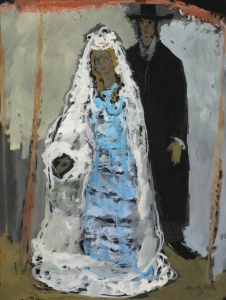
As we have come to expect, Sotheby’s December Judaica and Israeli Art sales are a memorable event. The artist Mane-Katz (1894-1962) (Ukraine, France, Israel) is well represented with four works of art, the most thrilling being The Wedding Couple. It is a truly stunning work in gouache on paper turning a simple Chasidic couple standing under a chuppah into a celebration of contrasts and color. The demure groom is clothed in black, totally outshone by his bride. She wears a delicate blue gown crowned by a shimmering white shawl and train that simultaneously celebrates her purity and, by the feverish brushstrokes, her passion. They stand under a barely sketched pink chuppah perched between pious ecstasy and artistic flourish, a genuine celebration of the bride in her moment of glory.
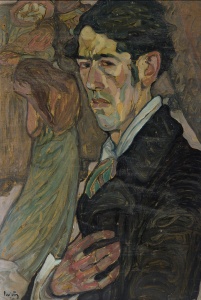
Reuven Rubin is always a staple at these auctions and the 16 paintings offered in the Israeli & International auction are no exception. His early (1920) dramatically expressionistic Self Portrait (catalogue #13) is a revelation of this 27-year-old artist’s work. Painted while he was still in his native Rumania, it is a riveting self-examination of an emotionally complex life, totally different from his characteristically cheerful holy land depictions. Another significant early Rubin is
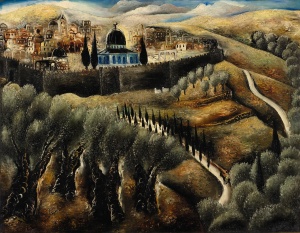
Jerusalem Seen from Mount Scopus (ca. 1927, catalogue #28). In a mere seven years he has become a totally different artist. The angst and anger of the self-portrait have yielded to a celebration of a newfound homeland, Palestine. The view is a prototypical conflation of Rubin’s favorite Palestinian landscape elements. The four massive olive trees in the foreground set the tone for the rest of the olive trees that seem to embrace the Old City. Cypress trees rhythmically dot the landscape while centrally featured is the Dome of the Rock on the Temple Mount, singularly blue against the earth-toned ancient buildings. Seeing the painting up close the richly painted surface resonates with the artist’s passion for the subject. We can detect a celestial glow of light behind the central mosque that allows some of the clouds to merge with the surrounding hills in a bit of atmospheric drama. Carmela Rubin (Rubin’s daughter-in-law) writes in the catalogue that “Jerusalem… always retained its magic for him, something well reflected in his many depictions of the city on canvas… he revered Jerusalem to such an extent that he rarely painted it from within or from close by. When he painted Jerusalem, he kept at a distance, seemingly, unable to allow himself the same intimacy characteristic of his Tel Aviv paintings.” This painting is a testament to Rubin’s love affair with the Holy City.
Aaron Wolff Herlingen of Gewitsch, Moravia, (active 1719-1752 in Vienna) was one of the greatest scribal artists in the 18th century revival of Hebrew manuscript illumination. We reviewed one of his works, a Haggadah of 1725, in the February 2010 review of the Braginsky collection, commenting that due to the nature of much of its imagery it may have been created for a woman. While similar in that aspect, this current auction offering, the
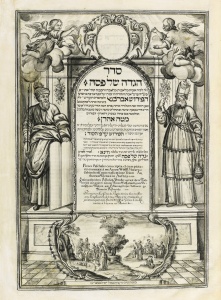
Herlingen Haggadah of 1730 (catalogue #122) is a towering masterpiece. Perusing its perfectly clean parchment pages is a breathtaking experience. The scribal work is of unrivaled quality, surpassing the finest printed page. Each of the four different commentaries surrounding the Haggadah text is hand-lettered in a different distinctive script. The page layout is meticulously creative and aesthetic, page after page. This elegant work is profusely illuminated with 60 text illustrations, many modeled on the copperplate engravings found in the Amsterdam haggadah of 1695. Additionally the illustrations of the Order of the Haggadah, the Plagues, “Who Knows One” and “Had Gadya” are originals by Herlingen himself. The Hodu text from Psalm 118:1-4 is elaborately rendered in “spare ground technique” that was often used in much larger medieval manuscript illumination. The technique creates a positive image on a dark ground by simply leaving the parchment bare to create the image. Here, this painstaking process has created delicate ornamented letters with details including a hunt, birds and an Adam and Eve in the Garden. A map of the Land of Israel, newly researched and drawn by the artist himself contains an extraordinary personal explanation of how and why he created a new and unique holy land map containing a corrected itinerary of the Children of Israel’s 40 year wanderings in the desert.
Perhaps most intriguingly there are mysteries. The illumination for “Pour Out Your Wrath” is an incongruously sweet depiction of two cherubs who bear two plaques with the four expressions of redemption. We call for the punishment of Israel’s enemies so as to open the door for our nation’s redemption in a perfect Rocco flourish.
And then there is the title page that proudly states the name of the scribe/artist, beautifully lettered in four languages (Hebrew, Latin, German and French) but does not state the patron of this extremely expensive (in its time) artwork. A cartouche at the top supported by two cherubs meant for the owner remains empty. Intriguingly the scene depicted in the bottom panel illustrates “In the merit of the righteous women, the Israelites were delivered from Egypt” (Sotah 11b). It relates how God arranged for small fish to enter their pitchers when the women would draw water in the fields, and the women would cook them for their husbands and, thus satisfied, would conceive many children who became the teeming Jewish population that demanded and finally got, liberation from Egyptian slavery. This is another distinctly female subject on a Herlingen Haggadah title page. Could it be that the commission from a wealthy woman somehow went wrong? Mystery and beauty abound in this truly mesmerizing masterpiece.
Sotheby’s Chanukah Auction: December 19, 2012
Important Judaica – 10am
Israeli & International Art – 2pm
1334 York Avenue at 72nd Street, New York, New York
Exhibition: December 14 – December 18, 2012 sothebys.com